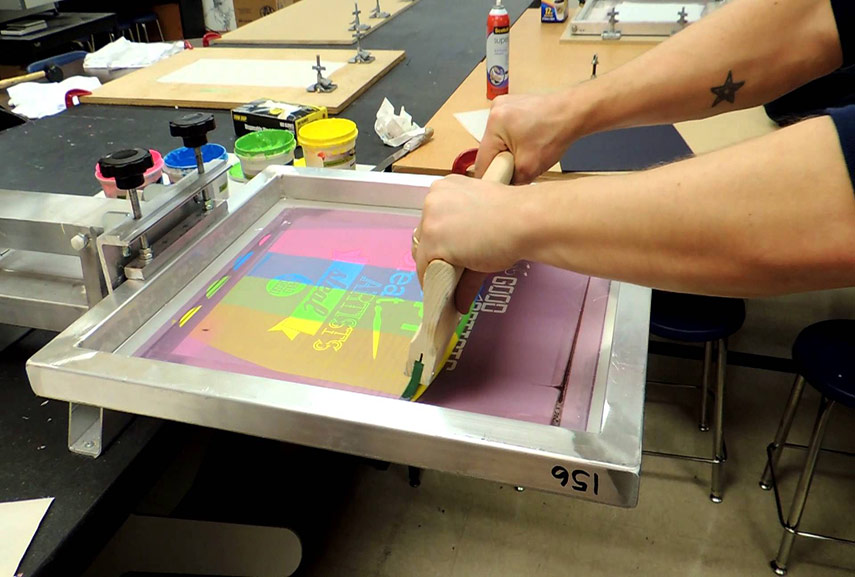The Essential Overview to Comprehending Screen Printing and Its Versatile Makes use of
Screen printing has an abundant history that dates back to old times, developing right into an innovative technique made use of across numerous industries today. This overview explores the ins and outs of the screen printing procedure, outlining its applications in home, advertising and marketing, and style décor - 10:9 Design Screen Printing Texas. Understanding these basics can open imaginative potential for both imaginative and business jobs. The complying with areas will certainly expose vital suggestions and methods to boost one's screen printing ventures
The History of Screen Printing
Although screen printing has roots that map back centuries, its advancement mirrors the imaginative and technical improvements of numerous cultures. Originating in old China, the method was at first utilized for embellishing textiles and later infect Japan, where it became indispensable to Ukiyo-e woodblock printing. The technique moved to Europe in the 18th century, where it gained appeal amongst artisans and business printers. The creation of image solution in the 20th century reinvented screen printing, enabling even more detailed styles and greater performance. Artists like Andy Warhol further pushed its appeal, utilizing the tool to develop legendary jobs that combined commercialism and art. By the late 20th century, screen printing had actually established itself as a versatile method, employed in vogue, advertising, and art. Today, it remains to develop, incorporating electronic modern technology and expanding its applications across various industries.
The Screen Printing Refine Explained
Screen printing changes creative visions into substantial styles with a series of accurate actions. Initially, a photo is developed and after that moved onto a screen, usually made of great mesh material stretched over a frame. A light-sensitive solution is put on the screen, which is subjected to light, hardening in areas not covered by the picture. After washing out the unhardened solution, a pattern is formed.
Next, the screen is positioned over the substrate, whether it be textile, paper, or another product. Ink is after that pressed with the open areas of the pattern using a squeegee, depositing the layout onto the substratum below. This process can be repeated for several colors, needing separate screens for each and every hue. The printed item is treated making use of warm to guarantee the ink sticks correctly, resulting in a durable, vibrant style ready for usage.
Sorts Of Screen Printing Techniques

Additionally, specialized techniques, such as discharge screen printing, remove dye from the textile to create softer prints, while aluminum foil screen printing uses metal foil to accomplish a glossy finish (10:9 Design reviews). Each technique offers distinct qualities, dealing with numerous creative demands and manufacturing scales, eventually expanding the possibilities within the screen printing domain
Applications of Screen Printing in Different Industries

Additionally, the signage and advertising and marketing industries utilize screen printing for developing captivating screens and banners. This method permits strong colors and detailed designs that record attention. In electronic devices, screen printing is used for using conductive inks to circuit boards, necessary for component links. Moreover, the home style market embraces screen printing to produce distinct layouts on textiles and wall art. In general, screen printing offers as a critical tool across diverse areas, boosting items with customized and aesthetically enticing graphics.
Tips for Effective Screen Printing Projects
While carrying out a screen printing project, cautious attention to detail can substantially boost the final outcome. Initially, picking top notch products is essential; this includes the screen, inks, and substratums. Making use of proper mesh counts can affect ink deposition and detail resolution. Prep work is just as vital; complete cleansing of screens and correct direct exposure times assure crisp prints.
Next off, precise registration is critical for multi-color prints. Using alignment devices can assist achieve exact layering. In addition, screening prints on scrap materials prior to production helps determine possible concerns without losing resources.

Often Asked Inquiries
What Materials Are Finest for Screen Printing on Material?
Cotton and polyester blends are excellent for screen printing on fabric due to their longevity and ink absorption. Furthermore, specialized textiles like silk or canvas can generate one-of-a-kind structures and finishes, boosting the general layout top quality.
Just how Do I Tidy and Maintain Screen Printing Equipment?
To clean up and keep screen printing devices, one need to routinely wash displays with appropriate solvents, check mops for wear, oil moving parts, and store all things in a completely dry, dust-free setting to prolong their life-span.
What Are the Ecological Impacts of Screen Printing?
Screen printing can have significant ecological effects, consisting of chemical waste from solvents and inks, water use throughout cleaning procedures, and power usage. Green products and lasting methods are essential for lessening these unfavorable results.
Can Screen Printing Be Done in the house Efficiently?
Screen printing can be successfully done at home with the ideal materials and techniques. Hobbyists can create quality prints, though success depends upon their ability degree, tools, and understanding of the procedure entailed.
What Are the Prices Related To Starting a Screen Printing Service?

Beginning a screen printing service involves costs for tools, products, and workspace. Preliminary costs commonly vary from a couple of hundred to a number of thousand dollars, depending on the scale, high quality of equipment, and wanted production capacity.
Screen printing has a rich background that dates back to old times, developing into an innovative strategy made use of across various markets today. An additional technique, rotating screen printing, utilizes cylindrical screens, promoting constant printing on fabric rolls, thereby boosting effectiveness for large manufacturings. Additionally, specialty techniques, such as discharge screen printing, get rid of color from the textile to produce softer prints, while aluminum foil screen printing applies metallic aluminum foil to accomplish a shiny coating. In the fashion field, screen printing is commonly made use of to develop vibrant styles on garments, allowing brand names to showcase their special designs. Cotton and polyester get more info blends are optimal for screen printing on fabric due to their sturdiness and ink absorption.